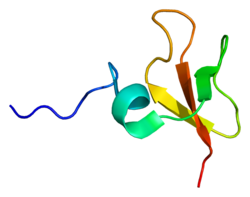- DEFB103A
-
Defensin, beta 103B 
PDB rendering based on 1kj6.Available structures PDB 1kj6 Identifiers Symbols DEFB103B; BD-3; DEFB103; DEFB103A; DEFB3; HBD3; HBP3 External IDs OMIM: 606611 MGI: 2675345 HomoloGene: 10256 GeneCards: DEFB103B Gene Gene Ontology Cellular component • extracellular region Biological process • positive regulation of biosynthetic process of antibacterial peptides active against Gram-positive bacteria
• defense response to bacteriumSources: Amigo / QuickGO Orthologs Species Human Mouse Entrez 55894 244332 Ensembl ENSG00000176797 ENSMUSG00000046354 UniProt P81534 Q14BD1 RefSeq (mRNA) NM_018661 NM_183026.2 RefSeq (protein) NP_061131 NP_898847.1 Location (UCSC) Chr 8:
7.78 – 7.78 MbChr 8:
19.19 – 19.2 MbPubMed search [1] [2] Beta-defensin 103 is a protein that in humans is encoded by the DEFB103A gene.[1][2][3]
Defensins form a family of microbicidal and cytotoxic peptides made by neutrophils. Members of the defensin family are highly similar in protein sequence. This gene encodes defensin, beta 103B, which has broad spectrum antimicrobial activity and may play an important role in innate epithelial defense.[3]
References
- ^ Jia HP, Schutte BC, Schudy A, Linzmeier R, Guthmiller JM, Johnson GK, Tack BF, Mitros JP, Rosenthal A, Ganz T, McCray PB Jr (Mar 2001). "Discovery of new human beta-defensins using a genomics-based approach". Gene 263 (1–2): 211–8. doi:10.1016/S0378-1119(00)00569-2. PMID 11223260.
- ^ Harder J, Bartels J, Christophers E, Schroder JM (Feb 2001). "Isolation and characterization of human beta -defensin-3, a novel human inducible peptide antibiotic". J Biol Chem 276 (8): 5707–13. doi:10.1074/jbc.M008557200. PMID 11085990.
- ^ a b "Entrez Gene: DEFB103A defensin, beta 103A". http://www.ncbi.nlm.nih.gov/sites/entrez?Db=gene&Cmd=ShowDetailView&TermToSearch=55894.
Further reading
- Hartley JL, Temple GF, Brasch MA (2001). "DNA cloning using in vitro site-specific recombination". Genome Res. 10 (11): 1788–95. doi:10.1101/gr.143000. PMC 310948. PMID 11076863. http://www.pubmedcentral.nih.gov/articlerender.fcgi?tool=pmcentrez&artid=310948.
- Sorensen OE, Thapa DR, Roupé KM, et al. (2006). "Injury-induced innate immune response in human skin mediated by transactivation of the epidermal growth factor receptor". J Clin Invest 116 (7): 1878–1885. doi:10.1172/JCI28422. PMC 1479426. PMID 16778986. http://www.pubmedcentral.nih.gov/articlerender.fcgi?tool=pmcentrez&artid=1479426.
- Tomita T, Nagase T (2001). "[Defensins as a mechanism of host defense and innate immunity]". Nippon Ronen Igakkai zasshi. Japanese journal of geriatrics 38 (4): 440–3. PMID 11523142.
- García JR, Jaumann F, Schulz S, et al. (2002). "Identification of a novel, multifunctional beta-defensin (human beta-defensin 3) with specific antimicrobial activity. Its interaction with plasma membranes of Xenopus oocytes and the induction of macrophage chemoattraction". Cell Tissue Res. 306 (2): 257–64. doi:10.1007/s004410100433. PMID 11702237.
- Biragyn A, Surenhu M, Yang D, et al. (2002). "Mediators of innate immunity that target immature, but not mature, dendritic cells induce antitumor immunity when genetically fused with nonimmunogenic tumor antigens". J. Immunol. 167 (11): 6644–53. PMID 11714836.
- Schibli DJ, Hunter HN, Aseyev V, et al. (2002). "The solution structures of the human beta-defensins lead to a better understanding of the potent bactericidal activity of HBD3 against Staphylococcus aureus". J. Biol. Chem. 277 (10): 8279–89. doi:10.1074/jbc.M108830200. PMID 11741980.
- Dunsche A, Açil Y, Dommisch H, et al. (2002). "The novel human beta-defensin-3 is widely expressed in oral tissues". Eur. J. Oral Sci. 110 (2): 121–4. doi:10.1034/j.1600-0722.2002.11186.x. PMID 12013554.
- Paulsen F, Pufe T, Conradi L, et al. (2003). "Antimicrobial peptides are expressed and produced in healthy and inflamed human synovial membranes". J. Pathol. 198 (3): 369–77. doi:10.1002/path.1224. PMID 12375270.
- Strausberg RL, Feingold EA, Grouse LH, et al. (2003). "Generation and initial analysis of more than 15,000 full-length human and mouse cDNA sequences". Proc. Natl. Acad. Sci. U.S.A. 99 (26): 16899–903. doi:10.1073/pnas.242603899. PMC 139241. PMID 12477932. http://www.pubmedcentral.nih.gov/articlerender.fcgi?tool=pmcentrez&artid=139241.
- Abiko Y, Nishimura M, Kusano K, et al. (2004). "Upregulated expression of human beta defensin-1 and -3 mRNA during differentiation of keratinocyte immortalized cell lines, HaCaT and PHK16-0b". J. Dermatol. Sci. 31 (3): 225–8. doi:10.1016/S0923-1811(03)00007-0. PMID 12727027.
- Nishimura M, Abiko Y, Kusano K, et al. (2003). "Localization of human beta-defensin 3 mRNA in normal oral epithelium, leukoplakia, and lichen planus: an in situ hybridization study". Medical electron microscopy : official journal of the Clinical Electron Microscopy Society of Japan 36 (2): 94–7. doi:10.1007/s00795-002-0206-8. PMID 12825122.
- Wu Z, Hoover DM, Yang D, et al. (2003). "Engineering disulfide bridges to dissect antimicrobial and chemotactic activities of human beta-defensin 3". Proc. Natl. Acad. Sci. U.S.A. 100 (15): 8880–5. doi:10.1073/pnas.1533186100. PMC 166407. PMID 12840147. http://www.pubmedcentral.nih.gov/articlerender.fcgi?tool=pmcentrez&artid=166407.
- King AE, Fleming DC, Critchley HO, Kelly RW (2004). "Differential expression of the natural antimicrobials, beta-defensins 3 and 4, in human endometrium". J. Reprod. Immunol. 59 (1): 1–16. doi:10.1016/S0165-0378(02)00083-9. PMID 12892899.
- Chadebech P, Goidin D, Jacquet C, et al. (2004). "Use of human reconstructed epidermis to analyze the regulation of beta-defensin hBD-1, hBD-2, and hBD-3 expression in response to LPS". Cell Biol. Toxicol. 19 (5): 313–24. doi:10.1023/B:CBTO.0000004975.36521.c8. PMID 14703118.
- Pernet I, Reymermier C, Guezennec A, et al. (2004). "Calcium triggers beta-defensin (hBD-2 and hBD-3) and chemokine macrophage inflammatory protein-3 alpha (MIP-3alpha/CCL20) expression in monolayers of activated human keratinocytes". Exp. Dermatol. 12 (6): 755–60. doi:10.1111/j.0906-6705.2003.00086.x. PMID 14714554.
- Yoshimoto T, Yamaai T, Mizukawa N, et al. (2004). "Different expression patterns of beta-defensins in human squamous cell carcinomas". Anticancer Res. 23 (6C): 4629–33. PMID 14981906.
- Joly S, Organ CC, Johnson GK, et al. (2005). "Correlation between beta-defensin expression and induction profiles in gingival keratinocytes". Mol. Immunol. 42 (9): 1073–84. doi:10.1016/j.molimm.2004.11.001. PMID 15829297.
- Varoga D, Pufe T, Harder J, et al. (2005). "Human beta-defensin 3 mediates tissue remodeling processes in articular cartilage by increasing levels of metalloproteinases and reducing levels of their endogenous inhibitors". Arthritis Rheum. 52 (6): 1736–45. doi:10.1002/art.21090. PMID 15934078.
- Niyonsaba F, Ushio H, Nagaoka I, et al. (2005). "The human beta-defensins (-1, -2, -3, -4) and cathelicidin LL-37 induce IL-18 secretion through p38 and ERK MAPK activation in primary human keratinocytes". J. Immunol. 175 (3): 1776–84. PMID 16034119.
PDB gallery Categories:- Human proteins
- Chromosome 8 gene stubs
Wikimedia Foundation. 2010.

